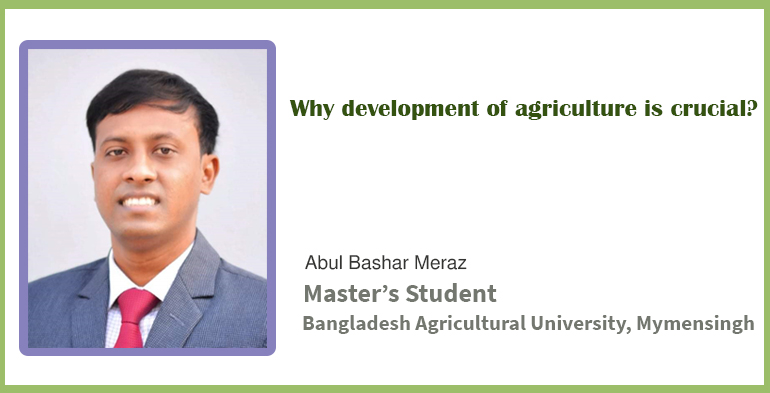
Abul Bashar Meraz:Agriculture and farmers are the backbone of Bangladesh's economy. The Constitution of Bangladesh identifies effective measures for the purpose of agricultural revolution, improvement of nutritional status of the people and development of public health as one of the duties of the state. Agriculture is closely linked with the life and livelihood of the people of Bangladesh. Economic development of this country is not possible without agriculture. Proper planning is essential for the overall development of the agricultural sector in line with the growing population of the country.
Agriculture plays an important role in increasing productivity and income and creating employment in rural areas for the prosperity of a large population. The agricultural sector i.e. crops, fisheries, livestock and forests contribute significantly to the country's GDP, providing employment to about half of the workforce and providing the main raw material for agro-based industries. Agriculture is a special field of social activity, which is deeply involved in important issues such as ensuring food and nutrition of the people, creating income opportunities and reducing poverty. In addition, agriculture is a source of demand-driven goods for a wide variety of consumer goods, especially in rural areas.
Agriculture is a combination of crops, fisheries, livestock and forest sub-sectors. The crop sector plays a very important role in the agriculture of Bangladesh and the crop sector is of utmost importance in various agricultural programs of the government. The amount of agricultural land in the country is decreasing at the rate of about 1 percent every year and the quality of soil is declining as a result of declining soil erosion and fertility and increasing salinity in the soil. In addition, water resources are shrinking. Adding value, including increasing agricultural productivity, diversification and diversification, is needed to produce more food and provide raw materials for agro-industries for a growing population on declining land.
In line with the Millennium Development Goals, the objective of the Government of Bangladesh is to bring the population living below the poverty line below 50 per cent. The 'Perspective Plan' also focuses on the need for rapid economic development of the population, higher growth in rural areas, agricultural development and development of non-agricultural economic activities related to rural agriculture in the country. It is possible to achieve higher GDP growth in agriculture by increasing the productivity of agriculture through application of modern agricultural technology and by connecting farmer's supply chain with consumers in national and international markets. This will reduce poverty in the country as well as improve the living standards of the people.
The role of small farms is more in agricultural Bangladesh. In order to reduce the poverty and improve the living standards of the rural population, it is essential to make the existing agricultural production system more dynamic and to introduce sustainable commercial agricultural production system. Combined efficient and effective agricultural technology management of agricultural research and extension is required for sustainable agricultural interaction and diversification through technological change. In this case proper value addition and proper market management assistance is required. In order to sustain knowledge-intensive agriculture, it is essential to maintain efficient human resource supply including productivity, resource utilization skills, use of up-to-date technology, increase in research and testing facilities. Further scientific and technical assistance is required for agriculture in Bangladesh. In today's multidimensional national and economic environment, there is a need to increase the efficiency of government expenditure in agricultural research and extension management.
Capacity in the agricultural sector of Bangladesh is: year-round favorable agro-climate for crop production, research-extension methods for technology innovation and technology expansion at farm level, expert, scientific and trained manpower for agricultural research and development, appropriate technology for major crop production, nationwide agriculture Material supply network, new and creative farmers interested in new technologies, adequate manpower for agricultural activities, extensive biodiversity of various crops, availability of irrigation water, existing supportive institutional and regulatory framework, existing financial support of government, extensive agricultural management monitoring network across the country. Useful guidelines for use of land and soil resources, traditional and experienced knowledge of farmers and agricultural subsidy cards and farmer bank accounts.
Weaknesses include: relatively poor agricultural marketing management, high post-harvest losses, inadequacy of farmer's own capital to manage agricultural activities, limited institutional agricultural credit, lack of farmer organization activism, limited inability to use materials, poor quality to meet export market demand Lack of suitable technology, insufficient investment in research and development at private level, scientists trained in advanced agricultural sciences, inadequate infrastructural facilities, lack of diversification in agriculture, poor management of agricultural inputs and lack of coordination between public and private universities and research institutes, training of farmers and entrepreneurs. Inadequacy, inadequacy of production and supply of quality agricultural inputs, preservation of agricultural products, inadequacy of processing and inadequacy of transportation system of agricultural products. The innovation and expansion of technology through agricultural research plays an important role in economic development.
Writer is a Master’s Student of Bangladesh Agricultural University, Mymensingh





















